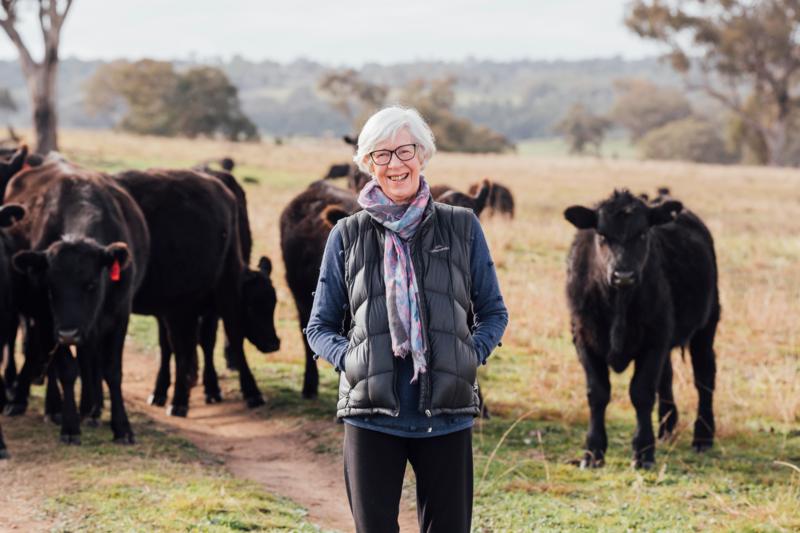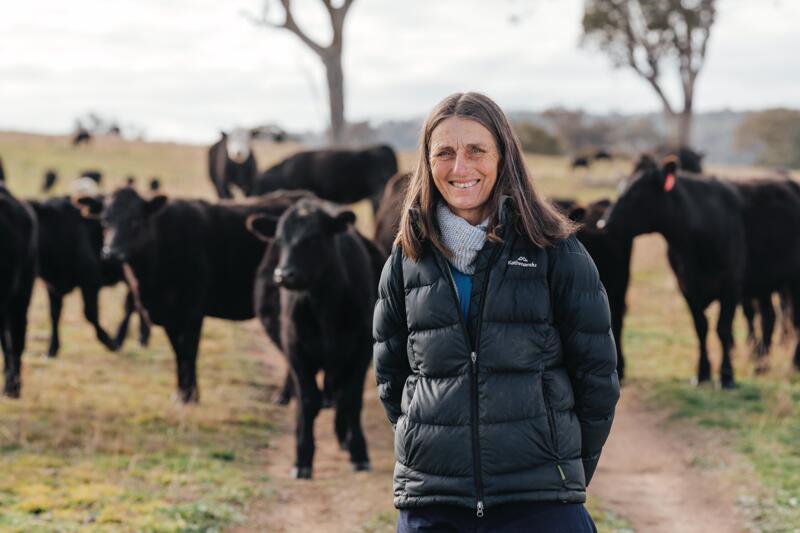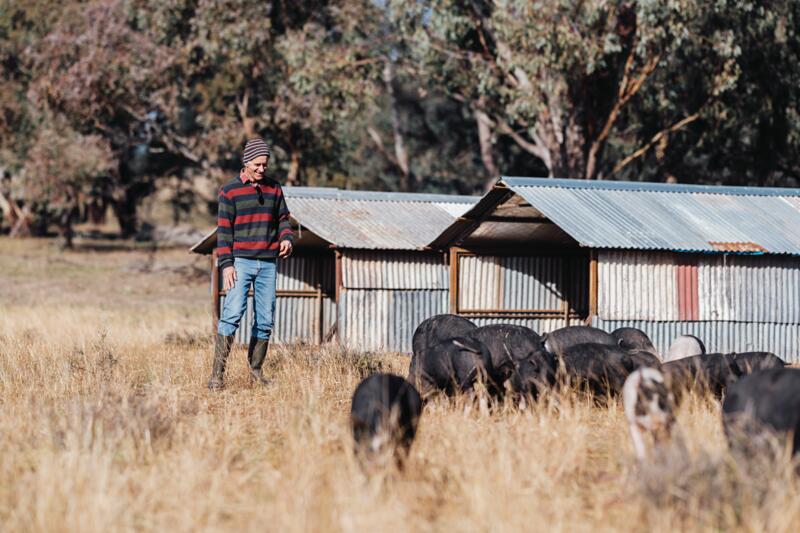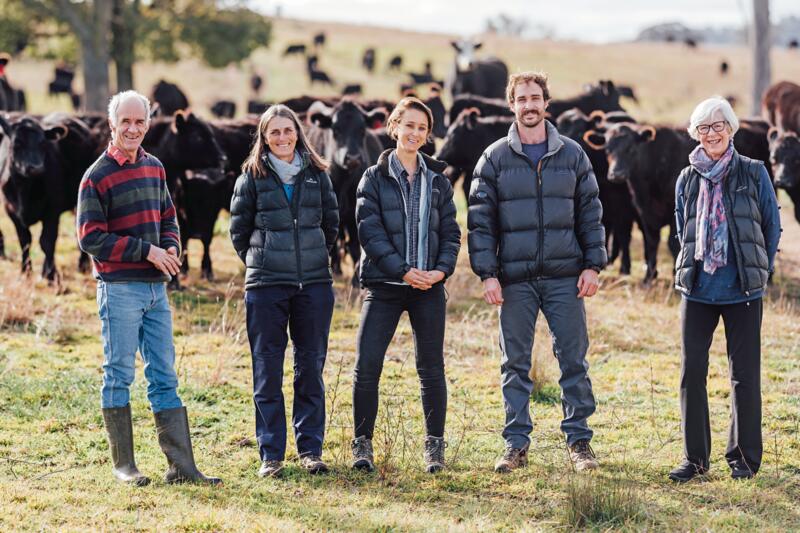Environmental mindset sets family up for regenerative agriculture
Marg Johnson, 87, cheerfully admits that despite marrying a farmer and loving the land, she was always more interested in literature than livestock.
“All our children are very environmentally minded and I think that comes from me. I couldn’t help myself planting trees everywhere, so they grew up with that.”
 Marg Johnson on the family’s family property.
Marg Johnson on the family’s family property.
I met my husband Jim after coming to work as a governess on the property next to his place at Murringo. He raised Shorthorn cattle and Merino sheep on this beautiful granite country and I just loved it.
Although I’d been raised in the country, I wasn’t really a hands-on farmer's wife. I wasn’t much good on a horse – they were inclined to get away from me, and I wasn’t good at fencing either. I’d think, oh my goodness, I wish this was over. But I did drive the truck when they were baling lucerne and took Anzac biscuits and billy tea, and I was always picking someone up or dropping them off, so I was sort of useful.
One time our lovely neighbour leaned over the back fence and said, “You know, Marg, you should remember to take some interest in the cattle prices and ask Jim how the sales went.”
When we first married, I couldn’t cook a thing but we had a dinner party for eight and I decided to cook crepes suzette at the table for dessert as I’d seen it done in Sydney. I asked Jim what I could cook it on, so he put his kerosene stove on the table and, of course, it burst into flames and took my eyebrows off. Everyone laughed so much they said it was one of the best dinner parties they’d ever been to.
We had four children, Anna, Sam, Will and Catherine. When I was pregnant with Sam we had a party line phone, which meant everyone knew everything. When I had to ring the hospital in the middle of the night because Sam was arriving, my neighbour picked up and said, “It’s on its way, is it? Don’t worry, I’ll hop into your bed and mind the other child.”
Property invaders get stiff awakening call
One weekend, Jim took all the children off to the Easter show and I was home alone when I spotted a suspicious grey van on our property. We’d had something stolen from the hay shed, so I called the police. I took them across the paddocks and got them stuck on a granite rock. They sat in their police car rocking back and forth for quite a while but they got off in the end. I really enjoyed watching the search as I’d been watching The Bill on TV. In the end they found someone who’d been stealing cattle so it was an exciting weekend.
When he was in his early 60s, Jim developed Parkinson’s, which was awful. We moved to Young and Sam and his family took over the farm. We divided everything equally between the kids and Sam sold part of the land to National Parks so everyone got a share.
All our children are very environmentally minded and I think that comes from me. I had such an appreciation of trees, space, clean water and all those lovely things and I couldn’t help myself planting trees everywhere, so they grew up with that.
Will is out at Cudal [in the Central Tablelands] now planting hundreds of trees all over the place and I’m very proud of the work he and Sam are doing. They’re real thinkers.
I’ve been fascinated by Sam’s introduction of regenerative grazing. It’s inspiring, a different way of handling the land and I’m proud of him. I also admire his wife Claire who’s very hands on. She has great ability and is a very different occupier of the place to me. I was more interested in, well, broadening my horizons.
RELATED: Reaping the rewards of biodynamic farming
.jpg) Free-range Berkshire/Hampshire-cross pigs are raised on the 1,500-hectare property.
Free-range Berkshire/Hampshire-cross pigs are raised on the 1,500-hectare property.
I did a bit of art and a book discussion club, which I’ve now belonged to for 50 years so that’s quite a feat. We’ve read all the Russian novels, French novels, poetry… I had to drive up to 100km for a meeting some nights. No wonder I had no time for fencing!
High quality paddock-to-plate produce adds value to branding
Claire Johnson, 60, and her husband Sam are holistic farmers who have embraced regenerative grazing.
“We move the cows and sheep onto fresh pasture at least once a day, sometimes two or three times. That’s my job, and I love it.”
 Claire and Sam run cattle with the sheep.
Claire and Sam run cattle with the sheep.
Farming has always been my love. I was raised on a farm in Coonamble, Central West NSW and feel you get a good perspective on life being outside and with nature.
Dad was a lover of Merino sheep so we farmed sheep and cattle. Mum was a strong character and a keen gardener, and she wouldn’t let Dad burn stubble like everyone else. She saw it was destroying all the carbon. They both made us question what other farmers were doing and when I met Sam I realised he was the same.
RELATED: Carbon grazing helping farmers manage land and livestock
After we married, we raised our three children, Sid, Annabel and Molly, on 24 hectares at Wombat, south of Young. We ran a permaculture farm with orchards and pasture-raised poultry. It was before the internet and farmers’ markets, so marketing was quite wearing.
 Sam and Claire Johnson approach to paddock-to-plate production has put them in control of their operation. Sam is tending to the pigs, which are moved to a new patch every week.
Sam and Claire Johnson approach to paddock-to-plate production has put them in control of their operation. Sam is tending to the pigs, which are moved to a new patch every week.
We’d write to a list of households to get an indication of what they might like and then every Sunday night, we’d call those who said they might want something. We’d process the chickens on Monday and deliver on Tuesday. We’ve got our own website now so people can just order online and it’s much easier.
Ruminant animals restore and regenerate the land
While at Wombat, Sam and I came across
the work of Zimbabwean Allan Savory and went to hear him speak. Sam had always thought hard-hoofed animals damaged the country but through Savory’s work we realised they were actually necessary for the regeneration of grasses and landscapes. It’s the complete opposite of what most Australians believe.
The secret is to move your stock into one big mob, reduce the time the animals are on a piece of land and extend the time that land remains ungrazed.
If you can get your animals to mull up the ground a bit and produce a seedbed, so long as you don’t come back to it too quickly, it will germinate a variety of grasses.
When we moved back onto Sam’s family farm in Murringo in 2002, we started regenerative grazing immediately. For us, on a productive piece of country, we run a mob of cows and sheep at about 5,000 dry sheep equivalent on about two hectares, and we move them onto fresh pasture at least once a day, sometimes two or three times. That’s my job, I go out with the dogs and I love it.
RELATED: "Out of the box" farming approach creates brand value
We have about 270 cows, 190 weaner cows and about 200 meat sheep. Since 2011, we’ve also raised free-range pork and their houses and water are moved weekly. They have a 50m by 50m paddock for about 50 grower pigs. They also get fed a ration, unlike the cattle and sheep, which don’t get any supplements or extra feed, even in winter or this drought, because they’re moving onto excellent pasture every day.
When Sam’s dad and my dad saw the results of regenerative grazing they were blown away, and my dad said, “Why isn’t everyone doing this?” I do think it takes a change of mindset though. People feel there’s a lack of control. We don’t fertilise, we don’t use chemicals, instead you have to watch how the land is reacting.
The sheep run with the cattle and we feel the cattle protect the lambs from the foxes. It took the sheep a while to get used to it but they like it now. I did worry a bit in summer as the cattle do boss them around but we have two water troughs including a low one sheep can drink from easily.
We used to send all our animals off to an abattoir in Cowra and then to a butcher in Young but as we expanded, four years ago we built our own butchery. Butchering now takes about half our time but it is maximising our profit. We have our own label,
Boxgum Grazing, and our own packaging designed by our daughter Annabel. We sell a lot more than we could have before – even offal and tails. Any waste we compost with sawdust and spread on the pasture.
Going forward, we’re in the process of transitioning ownership to Sid, Annabel and Molly and I think Sam will do more work promoting the
Savory approach. I’ll still be allowed to move the stock which is my daily joy, so I’m very pleased about that.
I’m happy about what we’ve achieved. We like feeling in control and every week at the farmers’ markets, a customer tells me our produce is the best they’ve ever tasted. We often think of crops as a commodity rather than a food and that’s a problem. Surely if you thought of your crops as food, you’d never spray chemicals on them.
I’m happy about what we’ve achieved. We like feeling in control and every week at the farmers’ markets, a customer tells me our produce is the best they’ve ever tasted. We often think of crops as a commodity rather than a food and that’s a problem. Surely if you thought of your crops as food, you’d never spray chemicals on them.
Agricultural upbringing sets young people up with real-world skills
While maintaining close ties to the family property, Annabel Johnson, 31, is helping drive agriculture forward as a policy director at NSW Farmers.
“When I understood I could benefit agriculture in an industry role, that really piqued my interest.”
.jpg) Mother and daughter Claire and Annabel catch up on the family farm. Annabel now works in Sydney at the head office of NSW Farmers.
Mother and daughter Claire and Annabel catch up on the family farm. Annabel now works in Sydney at the head office of NSW Farmers.
I was always a complete farm kid but the property I grew up on in Wombat was small, so my fondest memories are of staying at Mum’s family property [in Coonamble]. It was completely different – dry, hot and more isolated. My brother Sid, sister Molly and I spent fun times there.
My grandfather was a hard worker and I’d watch him and Mum going all day in the heat in the sheep yards and I thought Mum’s work ethic was incredible. She taught me that a physical limitation is only a limitation if you look at it that way. Although Sid was stronger than me, if I used a different technique or took a bit more time, I could still do what he did.
When Dad first returned to his family property [in Murringo] after uni, there was a drought and he got really upset seeing the environment in such a state and thought it was down to the animals. Since he came across Allan Savory, that’s all changed.
We border a national park that’s under a lot of grazing pressure from kangaroos and it’s a moonscape. We have an exclusion fence so they can’t get onto our property and we still have feed and habitat.
RELATED: Exclusion fence set to improve productivity after years of relentless drought
Mum and Dad pushed all of us to go to uni and I went to the Australian National University. In my fourth year I studied international trade law and came across an agreement that Australia uses to protect biosecurity. That opened my eyes to the threats of issues such as enhanced trade and watered-down restrictions and when I understood I could benefit agriculture in an industry role, that really piqued my interest.
 Right to left: Marg’s son Sam and his wife Claire, and their children Annabel and Sid, with the grass-fed Angus cattle.
Right to left: Marg’s son Sam and his wife Claire, and their children Annabel and Sid, with the grass-fed Angus cattle.
I’ve ended up as policy director – livestock at NSW Farmers. I’d always coveted the role and to work with an organisation that has such a history is fantastic. My grandparents were members so there’s a family connection. As I’ve been around farmers my whole life, I understand members’ concerns. I’m always thinking, How would Dad go getting his head around this?
There are so many things I love about farming. I love walking among the animals in the paddocks. I love the problem solving and the way no day is the same and I love the way you see results and outcomes.
We do everything on our farm, even the butchering and smoking hams. My brother taught himself butchery via YouTube after the butcher who was supposed to train him fell sick. He’s a typical farmer in that he didn’t give up. He just worked out how to get where he needed to go.
RELATED ARTICLES:
The Riverina farmers passionate about soil conservation
Sustainable Merino farm turns to perennial grasses
Coonamble family fight to save their farm from Inland Rail route